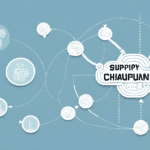The Ultimate Guide to Reverse Logistics
Reverse logistics is a strategic process of managing the flow of products after they have been sold and returned to the manufacturer or distributor. This process includes activities such as returns management, customer service, refurbishment, and recycling. In today’s business environment, reverse logistics is becoming increasingly important as it allows companies to reduce costs, minimize waste, and improve customer satisfaction. According to a 2023 industry report, effective reverse logistics can decrease operational costs by up to 30%.
What is Reverse Logistics and Why is it Important?
Reverse logistics involves managing the product lifecycle in the opposite direction, from the end user back to the manufacturer or distributor. This process is essential for reducing waste, minimizing environmental impact, improving customer satisfaction, and increasing profits. By optimizing their supply chains through effective reverse logistics, companies can better manage the return of products and their components, such as packaging materials and pallets.
Another critical aspect of reverse logistics is the management of product recalls. When a product is recalled, it must be removed from the market and returned to the manufacturer. Reverse logistics ensures that recalled products are properly handled and disposed of, thereby reducing the risk of harm to consumers and minimizing environmental impact. According to the 2023 Sustainability Report, effective recall management can enhance brand reputation and consumer trust.
Reverse logistics also plays a pivotal role in the circular economy. By managing the return and refurbishment of products, companies can extend the life of their products and reduce the need for new resources. This approach not only benefits the environment but also creates new business opportunities and revenue streams. The Circular Economy Whitepaper highlights that businesses adopting circular practices can see a revenue increase of up to 20%.
The Three Phases of Reverse Logistics
The reverse logistics process can be divided into three main phases:
- Returns Management: This phase involves managing the return of products from customers, including the coordination of collection, inspection, and disposition of the returned products.
- Refurbishment: This phase refers to the process of restoring returned products to their original condition or upgrading them to meet current standards.
- Disposition: This phase involves the final disposition of returned products, including recycling, disposal, or reuse.
Benefits of Implementing a Reverse Logistics Strategy
Implementing a reverse logistics strategy can bring numerous benefits, including:
- Reduced Costs: By managing returned products more effectively, companies can reduce costs associated with inventory holding, disposal, and replacement of lost or damaged goods.
- Improved Customer Satisfaction: Providing an efficient and hassle-free returns process enhances customer satisfaction and loyalty.
- Increased Profits: Refurbishing and reselling returned products can increase profits and recover some of the costs associated with returns management.
- Reduced Environmental Impact: Optimizing the return and disposal of products helps companies reduce their environmental footprint and contribute to a more sustainable future.
Common Challenges Faced in Reverse Logistics
Despite the benefits, companies often encounter several challenges when implementing reverse logistics strategies, including:
- Lack of Visibility: Many companies struggle with visibility into the return process, making it difficult to track products and identify inefficiencies.
- Complexity: Reverse logistics is inherently more complex than forward logistics due to multiple channels, stakeholders, and processes involved.
- Cost: Implementing a reverse logistics strategy can be expensive, especially for companies lacking the necessary infrastructure and technology.
- Regulations: Complying with various regulations related to the disposal, recycling, and refurbishment of products can be complex and time-consuming.
Best Practices for Managing Returned Goods
To effectively manage the return of goods, companies should follow these best practices:
- Establish a Clear Returns Policy: Outline the process for returning goods and the eligibility criteria to ensure consistency and transparency.
- Invest in Technology: Utilize systems that enable the tracking of returned products, including real-time updates on their location and condition.
- Provide Excellent Customer Service: Respond quickly to customer inquiries and complaints, and offer multiple support channels such as phone and email.
- Refurbish Products Promptly: Minimize the time returned products spend in inventory and reduce associated holding costs by refurbishing them quickly.
- Collaborate with Vendors and Suppliers: Work closely with partners to optimize the returns process, reducing costs and delays.
How to Optimize Your Reverse Logistics Process
Optimizing your reverse logistics process involves several strategic steps:
- Conduct a Comprehensive Assessment: Evaluate your existing reverse logistics operations to identify inefficiencies and areas for improvement.
- Invest in Tracking Technology: Implement technology that allows for the tracking and monitoring of returned products, providing real-time updates on their condition and status.
- Collaborate with Partners: Work closely with vendors and suppliers to streamline the returns process and reduce costs and delays.
- Establish a Clear Returns Policy: Develop a consistent policy that outlines the process for returning goods and the eligibility criteria.
- Train Your Staff: Ensure that your team is well-trained to manage the return process effectively and efficiently, providing ongoing support and training as needed.
The Role of Technology in Successful Reverse Logistics Management
Technology is critical for successful reverse logistics management, enabling companies to efficiently track and monitor returned products. Key technologies to consider include:
- Automated Tracking Systems: Provide real-time updates on the status and location of returned products.
- Reverse Logistics Software: Automates the returns process and offers real-time data analytics and insights.
- RFID Technology: Uses radio waves to track returned products, enhancing visibility and efficiency.
- Cloud-Based Logistics Platforms: Allow companies to manage the entire reverse logistics process from a centralized location.
Strategies for Reducing Costs in Reverse Logistics
To minimize costs in reverse logistics, companies should consider the following strategies:
- Invest in Real-Time Tracking Technology: Reduces costs associated with inventory holding and disposal by providing accurate tracking of returned products.
- Collaborate with Partners: Optimize the returns process through close collaboration with vendors and suppliers, reducing costs and delays.
- Streamline the Returns Process: Automate manual tasks and eliminate unnecessary steps to enhance efficiency.
- Refurbish Products Quickly: Decrease the time returned products spend in inventory, thereby reducing holding costs.
- Comply with Environmental Regulations: Ensure adherence to regulations related to disposal, recycling, and refurbishment to minimize legal and financial risks.
The Impact of E-commerce on Reverse Logistics
E-commerce has significantly impacted the reverse logistics industry by increasing both the volume and complexity of returned products. Key impacts include:
- Increased Volume of Returns: The convenience of online shopping has made it easier for consumers to return products, leading to a surge in return rates. According to a 2023 eCommerce Trends report, the return rate for online purchases can be as high as 30%.
- Increased Complexity: E-commerce has introduced more complex returns processes, requiring coordination from multiple channels and vendors.
- Greater Consumer Expectations: Online shoppers expect seamless and hassle-free returns experiences, necessitating efficient reverse logistics systems.
- Increased Environmental Impact: The rise in returns due to e-commerce has led to higher transportation costs and increased waste disposal challenges.
Case Studies: Successful Implementation of Reverse Logistics
Several companies have successfully implemented reverse logistics strategies, resulting in improved customer satisfaction, reduced costs, and increased profits. Notable examples include:
- Apple: Apple's Apple Renew program allows customers to trade in their old devices for discounts on new purchases. Apple refurbishes these devices and resells them as certified refurbished products, reducing electronic waste and creating additional revenue streams.
- Amazon: Amazon has developed an efficient returns process that enables customers to return products quickly and easily. The company has invested in advanced technologies, including robotics and automation, to enhance its reverse logistics operations, ensuring timely processing and cost reduction.
Future Trends in Reverse Logistics Industry
The reverse logistics industry is rapidly evolving, with several key trends shaping its future:
- Increased Use of Technology: Adoption of automation, artificial intelligence (AI), and robotics is expected to rise, improving efficiency and reducing costs.
- Greater Collaboration: Enhanced collaboration among stakeholders, including vendors, suppliers, and customers, will lead to greater efficiency and reduced costs.
- Emphasis on Sustainability: Sustainability will become a central focus, with companies investing in green technologies and implementing sustainable practices to reduce their environmental impact.
- Importance of Data Analytics: Advanced data analytics will play a crucial role in reverse logistics management, enabling companies to identify inefficiencies and optimize operations.
How to Build a Sustainable Reverse Supply Chain
Building a sustainable reverse supply chain involves implementing a range of practices that minimize waste, reduce costs, and contribute to a more sustainable future. Key practices include:
- Recycling Returned Products: Recycle returned products and their components, such as packaging materials and pallets, to reduce waste.
- Investing in Green Technologies: Utilize renewable energy sources and eco-friendly transportation methods to lower the environmental impact of reverse logistics operations.
- Partnering with Sustainable Suppliers: Collaborate with suppliers and vendors who share a commitment to sustainability, ensuring that sustainability is maintained throughout the supply chain.
- Implementing Sustainable Practices: Integrate sustainable practices into all aspects of the supply chain, from product design to end-of-life management.
Measuring Success: Key Performance Indicators for Reverse Logistics
To evaluate the success of your reverse logistics strategy, it is essential to track key performance indicators (KPIs), including:
- Cost of Returns: Monitor the costs associated with managing returns, including logistics, labor, and storage expenses.
- Cycle Time: Measure the time it takes to process returned goods from receipt to disposition, encompassing inspection, refurbishment, and disposal stages.
- Customer Satisfaction: Assess customer satisfaction with the returns process, focusing on ease of use, efficiency, and the quality of customer support.
- Refurbishment Rate: Track the percentage of returned products that are refurbished and resold, indicating the effectiveness of refurbishment processes.
Collaborating with Suppliers and Partners in the Reverse Supply Chain
Collaboration with suppliers and partners in the reverse supply chain can yield numerous benefits, such as:
- Reduced Costs: Partnering with suppliers and partners helps optimize the returns process, lowering costs related to inventory holding, disposal, and replacement of lost or damaged goods.
- Improved Efficiency: Collaborative efforts streamline the returns process, reducing cycle time and enhancing overall efficiency.
- Enhanced Customer Satisfaction: A well-coordinated returns process provides a seamless experience for customers, boosting satisfaction and loyalty.
- Increased Profits: Effective collaboration allows for the refurbishment and resale of returned products, contributing to higher profits.
Conclusion
Reverse logistics is a vital component of modern supply chain management. By effectively managing the flow of products in reverse, companies can reduce costs, minimize waste, and enhance customer satisfaction. To implement a successful reverse logistics strategy, companies should invest in advanced technology, collaborate closely with suppliers and partners, and adopt sustainable practices. Measuring the success of your reverse logistics strategy involves tracking key performance indicators such as cost of returns, cycle time, customer satisfaction, and refurbishment rate. Embracing these practices will not only improve operational efficiency but also contribute to a more sustainable and profitable business model.



















